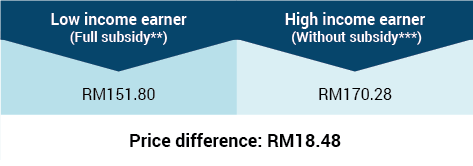Fuel Subsidy Scrapped For High-Income Earners
The newly announced petrol subsidy rationalisation mechanism will see high-income earners paying the “real” market price for RON95, while those under the low-income bracket will pay the subsidised rate for RON95. The current market rate for RON95 is RM2.58 per litre, while the subsidised price is RM2.30 per litre. This dual-pricing petrol subsidy rationalisation mechanism is expected to be implemented June next year.
The quantum of distribution for fuel subsidy will be based on individual’s income.
On Monday, Second Finance Minister Datuk Seri Ahmad Husni Hanadzlah said the programme would be divided into three tiers:
Those earning below RM5,000 per month will receive full subsidy, those earning between RM5,000 and RM10,000 will get a partial subsidy, while those who earn more than RM10,000 per month will not enjoy any fuel subsidy under the new scheme. In order to determine one’s income range, motorists will be required to present their MyKad, which will incorporate data from the Inland Revenue Board (LHDN), when purchasing fuel at petrol stations.
However, the full mechanism was still being studied by the Domestic Trade, Cooperatives and Consumerism Ministry.
Let us look at how much fuel will cost for the following income groups driving a Proton Preve*:
 * Fuel consumption for Proton Preve is 66L/1,000km. Assuming total mileage a month at 1,000km.
* Fuel consumption for Proton Preve is 66L/1,000km. Assuming total mileage a month at 1,000km.
**Full subsidy = Assuming it follows the current subsidy rate of RM2.30 per litre
***Without subsidy = Assuming it follows the market rate RM2.58 per litre
As the quantum is based on income and not the types of car, an individual from the low-income group driving a luxury car may save a whole lot more than lower range cars. However, the truth is, most people from the low-income group will probably not be able to afford a car, or own a motorcycle, making the saving from the subsidy less significant compared to those driving a bigger car.
Those from the middle and high-income groups will most probably consider hybrid cars to drive their petrol consumption down after the implementation.This could especially be true for motorists who use their vehicles excessively, especially for work purposes, such as salesmen, real estate property agents, insurance agents, and consultants.
Will this work?
According to the Department of Statistics Malaysia, the mean monthly household income for a Malaysian household is RM5,000. If the income for full fuel subsidies is capped at RM5,000, it may affect a large section of motorists, who will need to pay more than the current market price.
This will be especially true for major cities as the mean monthly household income is RM5,742 in urban areas. For those in the middle-income who were forced to move out of the city due to the high property prices, have to commute excessively to work in the city every day. Though many will benefit from the partial subsidy rates, for the middle-income group, every single sen increased in fuel could make a big impact on their spending.
Besides that, we may also see the lower-income individuals helping others to fill up in the station, to save on fuel. This means that motorists could misuse the privileges for a quick buck.
In order to prevent this, the Government may need to set a maximum fuel usage for every individual. If they use more than that, they will have to pay the full price. However, the lower-income group may not be able afford a car and therefore do not use one or might just be using a motorcycle and may not require as much fuel. So, they can always help out the higher-income individual.
This will also create an opportunity for some to profit from the subsidy, where a certain segment of the lower-income group may take advantage of this opportunity to make money by buying petrol at a subsided rate and later sell it to the higher-income group at the market rate. This could encourage fuel smuggling in the black market for a cheaper price, then at the petrol station, leading to law and order issue.
Integrating income details into MyKad could be dangerous, as it exposes private and confidential information of Malaysians income to others easily. If not done with precaution, this new system could cause our income details to be easily accessible by frauds.
Some other details that need to be ironed out by the authorities are:
- How will the fuel subsidy be implemented if the motorist is a foreigner?
- So what happens if there is an error in the reading of the MyKad – maybe a faulty chip or reader? Would the default price be the highest price if MyKad is not presented?
- How would fuel be subsidised for company vehicles?
Many await the full details of the fuel rationalisation mechanism with bated breaths. More tiers would ensure that the middle-income group still gets to enjoy a certain level of subsidy for fuel usage, and in doing so, helps alleviate their financial burdens.
What do you think of the new fuel subsidy scheme? Let us know your thoughts in the comment section below.












